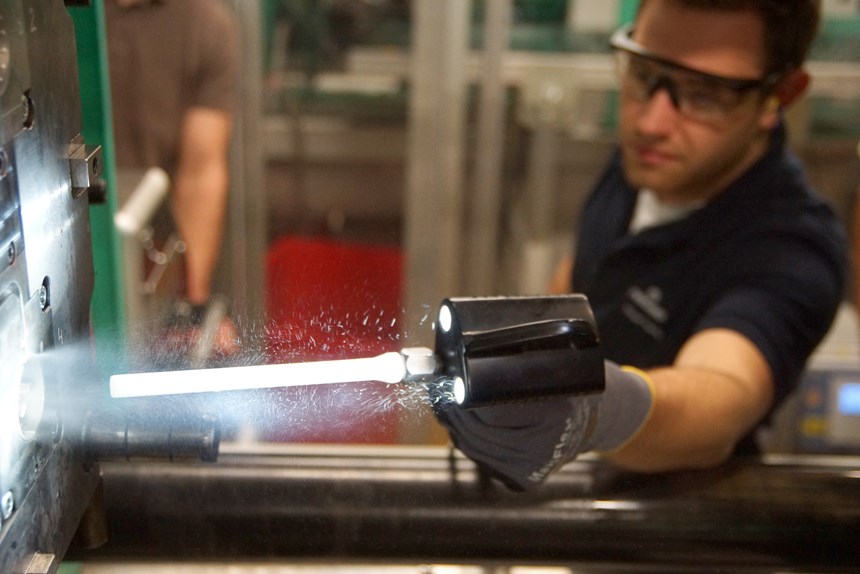Mold Cleaning Beyond Conventional Methods
For Tyco Electronics conventional cleaning processes for its injection molding equipment were cutting into vital production time, so the company switched to dry ice blast cleaning.
Tyco Electronics is the world’s largest supplier of passive electronic components for the automotive industry, and it was still using conventional processes to cleaning its injection molds, which was taking too much time and effort.
“The molds are vital to our business, and the fact that we had to remove them and transport them around the plant places them at risk of being damaged. To protect the molds and improve our productivity, we recognized that we needed a better cleaning solution,” Jan Schotte, Process Technology – Plastics, Tyco Electronics Belgium EC N.V., Global Automotive Division says.
Featured Content
One particular Tyco Electronics plant in Belgium that manufactures automotive connectors for air bags and other safety components has more than 300 molds, 10 of which are used on Tyco Electronics’ heavy-duty, long- run machines. The long-run machine molds are used to make three to four products that range in size from 1 cm to 15 cm and weigh approximately 5 to 200 grams.
During production, these molds must be cleaned once every 48 hours. Plastic material builds upon the molds during manufacturing and can cause blemishes on the parts, making the molds dirty and blocking the molds’ small vents. When the vents are clogged, the material cannot outgas, which results in burn marks on the molded parts.
To clean the molds, Tyco Electronics tried ultrasonic, Teflon blasting, solvents and hand scraping. While these processes helped to remove the plastic build-up, they were very time consuming. The methods presented risks to both equipment and people, and required long periods of production stoppage.
Taking a Turn Toward Dry Ice
Tyco Electronics was then introduced to Cold Jet’s i3 MicroClean® system, a lightweight, compact, single-hose, low pressure, cleaning system that features Cold Jet’s patented shaved dry ice technology. The system uses a dry ice block with as little as 12 cfm and blasts at variable air pressures from 20 to 125 psi. The combination of noise restrictions, as well as the size of the small cavities in Tyco Electronics’ molds made the MicroClean patented shaved ice system an ideal solution for the parts manufacturer.
Dry ice cleaning is a dry process and is non-conductive, enabling it to be used to clean equipment while it is still hot, eliminating timely cool-down and reheating periods. Dry ice cleaning is also non-abrasive and will not damage or dull molds. Cleaning with Cold Jet’s MicroClean system reduces risks to equipment and people associated with pre- and post-cleaning processes because it eliminates the need to disassemble or move hot equipment.
The MicroClean system uses recycled carbon dioxide (CO2), in the form of solid dry ice particles that are accelerated through high-velocity nozzles to impinge upon the surface being cleaned. The combination of the kinetic energy and thermal gradient effects of the dry ice breaks the bond between the residue and the surface. The residue falls away from the surface and is easily disposed of. The dry ice particles sublimate on impact, eliminating the added cost and inconvenience of secondary waste treatment and disposal, as well as any downstream contamination.
With the MicroClean system, cleaning one of the molds for Tyco Electronics’ long-run machines takes one person less than an hour, reducing the actual cleaning time using scraping or abrasive media blasting by as much as 11 hours.
Since introducing the MicroClean at the Belgium plant, Tyco Electronics has deployed dry ice cleaning systems at 12 of its locations in Europe and five locations in North America. Tyco Electronics is also finding other areas within its plants where dry ice cleaning can help, including the metal stamping departments to quickly clean metal scraps from stamping machines.
By deploying Cold Jet’s i3 MicroClean solution, Tyco Electronics was able to reduce a 6-12 hour cleaning process to one hour, and reduce a cleaning crew of multiple people to a single person. The company established an investment return hurdle rate of 18 months, but saw benefits immediately as the system paid for itself in slightly more than one month.
About the Author
Steve Wilson is the Global Business Unit Manager – Plastics, Rubber & Composites for Cold Jet. As a former plastics business owner he has over 30 years of experience in injection & compression molding, extrusion, blow molding, thermoforming and rotational molding. He began his career at Milacron’s plastics machinery division, serving in manufacturing, product line management and a variety of sales/marketing roles. Steve is a published author and a frequent speaker at plastics industry events. He holds a Bachelor’s degree in Business Administration from Cedarville University and an MBA from Xavier University.
swilson@coldjet.com
RELATED CONTENT
-
Detecting Water Flow Restrictions
A look at how taking the time and data to analyze a mold problem will help you repair it right—and permanently—the first time.
-
Hands-on Workshop Teaches Mold Maintenance Process
Intensive workshop teaches the process of mold maintenance to help put an end to the firefighting culture of many toolrooms.
-
How to Use Flushing to Clean Cooling Passages and Heat Exchangers
Six key questions to ask before investing in a flushing system.
_970x90 4.png;maxWidth=970;quality=90)








_970x250 1.png;maxWidth=970;quality=90)




